UNIT 12 YOU’RE SUPPOSED TO SHAKE HANDS.教学设计
九年级英语全册 Unit 12 You’re supposed to shake hands全单元课件 人教新目标版
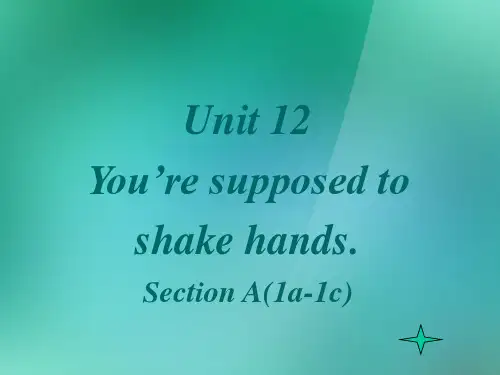
Maria: I was supposed to arrive at 7:00 , but I arrived at 8:00.
Maria: In my country, it’s different. When you’re
invited for 7:00, you’re supposed to come late. r
shake hands.
Section A(2a-2c)
2a Listening Maria’s mistake
2a Maria is an exchange student. Last night she had dinner at an American friend’s house. Listen and check (√) the mistakes Maria made.
Unit 12 You’re supposed to
shake hands.
Section A(1a-1c)
We are not supposed to eat in class.
We …
be supposed to do
被期望或要求做…; 应当做…
be not supposed to do 不被许可做…;不应当做…
Dan: I see. Maria: Then when I met Paul’s mom, I
kissed her. Dan: And you were supposed to shake
hands instead. Maria: That’s right. AND I wore a fancy
dreቤተ መጻሕፍቲ ባይዱs.
countries we shake hands.
Unit 12:You're supposed to shake hands
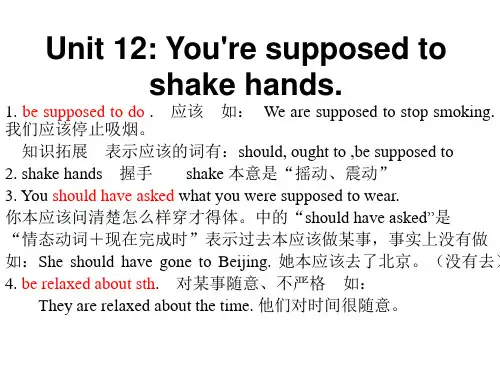
• 36. My partner was doing homework __w_h_i_le__I _w_a_s_l_is_te_n_i_n_g_t_o_m__u_s_ic______________ ______(而我在听音乐) (listen)
• 37. He won’t be good at the subjects ___u_n_le_s_s__h_e_w_o_r_k_s_h_a_r_d_(_a_t_th_e_m__)___________ _________ (除非他努力学习) (work)
• 44. Do you know
________if__F_r_e_n_c_h__i_s__s_p_o_k_e__n__in__C__a_n_a_d__a_
________________________? • (加拿大是否说法语) (speak)
• 45. Do you mind
____s_to__p_p_in_g__s_m__o_k_in_g__i_n_p_u__b_li_c___________ ____=__g_i_v_in_g__u_p__s_m__o_k_in_g__in__p?ublic
• 3____8__. __W__e__wu____no__tni__l’__th__lee__ra__mv__e__o__tt__hh__ee__r__kr__ied__t’u__s__rhn__os__m____e________(_直__到__
孩子妈妈回来才会离开她家) (return)
• 39. Carmen
• 17. go out of one’s way to do 特意,专门做某事 如: • He went out of his way to make me happy. 他特意使我高兴。 • get/be used to sth. 习惯于… • get/be used to doing 习惯于… • be used to do 被用于做… • be used for doing 被用于做… • used to do 过去常常做… 如:
九年级英语教案Unit12You’resupposedtoshakehands
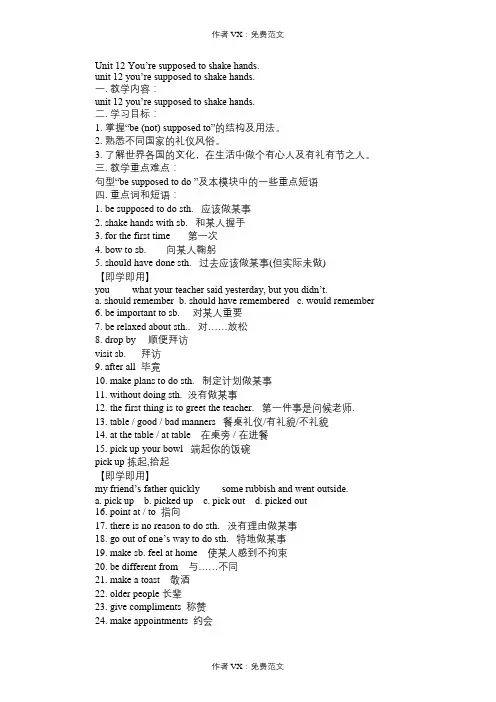
Unit 12 You’re supposed to shake hands.unit 12 you’re supposed to shake hands.一. 教学内容:unit 12 you’re supposed to shake hands.二. 学习目标:1. 掌握“be (not) supposed to”的结构及用法。
2. 熟悉不同国家的礼仪风俗。
3. 了解世界各国的文化,在生活中做个有心人及有礼有节之人。
三. 教学重点难点:句型“be supposed to do ”及本模块中的一些重点短语四. 重点词和短语:1. be supposed to do sth. 应该做某事2. shake hands with sb. 和某人握手3. for the first time 第一次4. bow to sb. 向某人鞠躬5. should have done sth. 过去应该做某事(但实际未做)【即学即用】you what y our teacher said yesterday, but you didn’t.a. should rememberb. should have rememberedc. would remember6. be important to sb. 对某人重要7. be relaxed about sth.. 对……放松8. drop by 顺便拜访visit sb. 拜访9. after all 毕竟10. make plans to do sth. 制定计划做某事11. without doing sth. 没有做某事12. the first thing is to greet the teacher. 第一件事是问候老师.13. table / good / bad manners 餐桌礼仪/有礼貌/不礼貌14. at the table / at table 在桌旁 / 在进餐15. pick up your bowl 端起你的饭碗pick up 拣起,拾起【即学即用】my friend’s father quickly some rubbish and went outside.a. pick upb. picked upc. pick outd. picked out16. point at / to 指向17. there is no reason to do sth. 没有理由做某事18. go out of one’s way to do sth. 特地做某事19. make sb. feel at home 使某人感到不拘束20. be different from 与……不同21. make a toast 敬酒22. older people 长辈23. give compliments 称赞24. make appointments 约会25. behave differently 表现不同26. begin with 从……开始27. not … but… 不是……,而是……28. questions crowded my mind. 我满脑子都是疑问。
九年级英语-Unit_12_You_are_supposed_to_shake_hands教案AlKKwq

Unit 12 You are supposed to shake hands.咸保中学王金林内容提示本单元主要是通过对一些国家的风俗习惯,礼仪差异,时间观念和饮食文化的学习,进一步提高学生对文明生活的认识,加深学生对中外文化的了解,拓展学生的文化视野。
教学目标一、语言目标了解一些国家的饮食起居、生活习惯和文化异同,并用学习的知识表达自己对生活习惯的看法。
二、认知目标掌握关键词汇和目标语言。
(一)重点词组1. shake hands2. be supposed to do3. make some mistakes4.make plan to do5. on time6. after all7. get angry 8.tabble manners9. pick up 10.take a drink11. make noise 12.point out13. it’s rude to do…14.have a great time15.get used to … 16.make appointments17.make a toast(二)交际用语1. A: What are you supposed to do when you meet someone?B: We’re supposed to shake hands / kiss / bow.2. A: When were you supposed to arrive?B: I was supposed to arrive on time.3. You should have asked what you were supposed to wear.4. You are not supposed to shake hands.5. Spending time with friends is very important.6. We never visit a friend’s house without calling first.7. You are not supposed to stick your chopsticks into your food.(三)现在完成时的用法三、情感目标本单元以谈论“习俗”为话题,了解各地不同的文化知识,从而让学生知道哪些是应该做的,哪些是不应该做的,要学会尊重不同的文化,养成良好的行为习惯,培养学生的学习兴趣。
九年级英语 Unit 12 You’re supposed to shake hands单元知识汇编
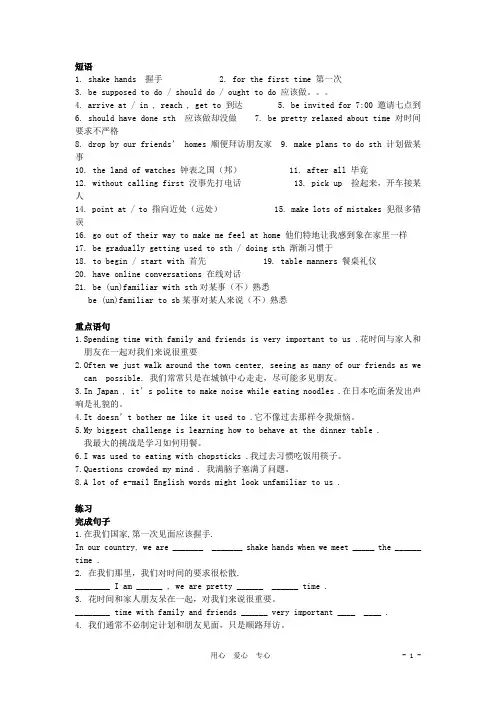
短语1. shake hands 握手2. for the first time 第一次3. be supposed to do / should do / ought to do 应该做。
4. arrive at / in , reach , get to 到达5. be invited for 7:00 邀请七点到6. should have done sth 应该做却没做7. be pretty relaxed about time对时间要求不严格8. drop by our friends’ homes 顺便拜访朋友家 9. make plans to do sth 计划做某事10. the land of watches 钟表之国(邦) 11. after all 毕竟12. without calling first 没事先打电话 13. pick up 捡起来,开车接某人14. point at / to 指向近处(远处) 15. make lots of mistakes 犯很多错误16. go out of their way to make me feel at home 他们特地让我感到象在家里一样17. be gradually getting used to sth / doing sth 渐渐习惯于18. to begin / start with 首先 19. table manners 餐桌礼仪20. have online conversations 在线对话21. be (un)familiar with sth对某事(不)熟悉be (un)familiar to sb某事对某人来说(不)熟悉重点语句1.Spending time with family and friends is very important to us .花时间与家人和朋友在一起对我们来说很重要2.Often we just walk around the town center, seeing as many of our friends as we can possible. 我们常常只是在城镇中心走走,尽可能多见朋友。
最新新人教版英语九年级《unit 12 you’re supposed to shake hands》教案.doc
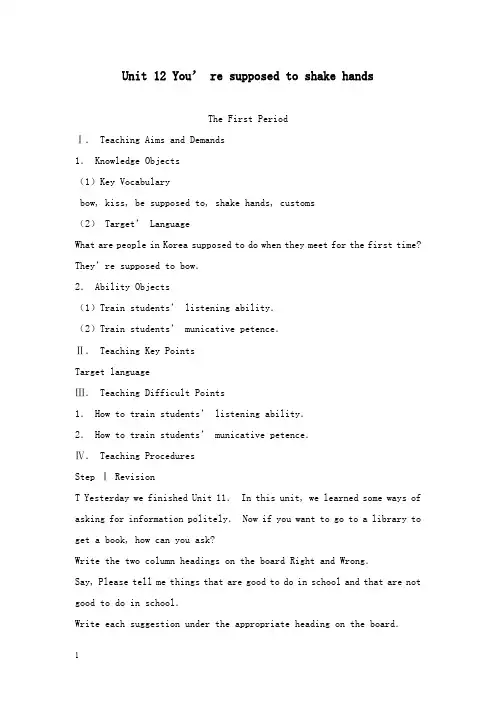
Unit 12 You’ re supposed to shake handsThe First PeriodⅠ. Teaching Aims and Demands1. Knowledge Objects(1)Key Vocabularybow, kiss, be supposed to, shake hands, customs(2) Target’ LanguageWhat are people in Korea supposed to do when they meet for the first time? They’re supposed to bow.2. Ability Objects(1)Train students’ listening ability.(2)Train students’ municative petence.Ⅱ. Teaching Key PointsTarget languageⅢ. Teaching Difficult Points1. How to train students’ listening ability.2. How to train students’ municative petence.Ⅳ. Teaching ProceduresStep Ⅰ RevisionT Yesterday we finished Unit 11. In this unit, we learned some ways of asking for information politely. Now if you want to go to a library to get a book, how can you ask?Write the two column headings on the board Right and Wrong.Say, Please tell me things that are good to do in school and that are not good to do in school.Write each suggestion under the appropriate heading on the board.T Is it a good idea to e to class late?No.S1T That’s right, It’s not a good idea to e to class late. You’re not supposed to e to class late. Class repeat. You’re not supposed to e to class late.You’re not supposed to e to class late.SsT (Writes e to class late under wrong) What are some things you shouldn’t do?We shouldn’t eat in class.S2T Right. You’re not supposed to eat in class.Ask students to repeat this example.Then ask students to tell about some things that are good to do in school. They may say things such as, You should do your homework every day; You should raise your hand before you talk. Rephrase each of these sentences using supposed to and ask students to repeat You’re supposed to do your homework every day.You’re supposed to raise your hand before you talk.Step Ⅱ 1aLet students read the instructions.Point to the two lists of words. Read each word and ask students to repeat it.Put up a map of the world on the board.Ask students to explain where each of the countries is.Ask different students to act out the action described by each word or phrase—bow, shake hands, and kiss.Read the instructions again and ask students to match the customs lettered a, b and c with the numbered countries.Look at the sample answer. Tall students to guess if they aren’t sure.Step Ⅲ 1bGo through the instructions with the class. Point to the lists in Activity la and say, Now you will hear a conversation between a boy and a girl. Their conversation contains the answers to the questions inActivity 1a.Play the tape for the first time. This time, students only listen.Play the tape a second time. Ask them to listen to the recording and check their answers to Activity 1a.Check the answers with the class. Invite a student to read the answers.Step Ⅳ 1cRead the instructions to the whole class.Point out the example in the box. Ask two students to read it to the class.Point to the lists of customs and countries in Activity la. Tell students to first talk about these countries and customs, and then talk about other countries and customs they know about.As students work together, move around the classroom checking their work.Ask different pairs of students to ask and answer a question for the class.Step ⅤHomeworkReview the target language.The Second PeriodⅠ. Teaching Aims and Demands1. Knowledge Objects(1) Key Vocabularygreet, be supposed to(2)Target LanguageHow was the dinner at Paul’s house last night?Well, it was OK, but I made some mistakes. I was supposed to arrive at 700, but I arrived at 800.2. Ability Objects(1) Train students’ listening ability.(2) Train students’ municative petence.3. Moral ObjectsWhen you’re invited to a place, you mustn’t be late, greet people the wrong way and wear the wrong clothes. That is, you should act according to your host’s customs.Ⅱ. Teaching Key Points1. Key Vocabularygreet, be supposed to2. Target LanguageHow was the dinner at Paul’s house last night?Well, it was OK, but I made some mistakes. I was supposed to arrive at 700, but I arrive at 800.3. StructureWhat are you supposed to do when you meet someone?Ⅲ. Teaching Difficult Points1. the target language2. How to improve students’ listening ability.Ⅳ. Teaching ProceduresStep Ⅰ RevisionCheck homework. Ask some pairs to act out their conversations according to Activity 1a.Step Ⅱ 2aLook at the picture and ask students to tell What is happening.Help students understand that the people are at a picnic.Point to Maria and ask, what’s Maria wearing? (She is wearing a dress.)Ask, Does she look fortable? (No.)Read the instructions and point to the four mistakes on the list. Ask different students to read the mistakes to the class.Listen to Maria talking to a boy about what happened at the picnic. She made several mistakes. Listen to the recording and check the mistakes she made.Play the recording. Students only listen the first time.Play the recording again. Get students to check the mistakes Maria made.Check the answers with the class.Step Ⅲ 2bGo through the instructions with the class. Point out the blanks in the four sentences. Invite a student to read the first sentence.Play the recording again. Let students fill in the blanks with the words they hear alone.Correct the answers with the class.Step Ⅳ 2cRead the instructions for the activity to the class.Look at the example in the box. Ask two students to read the conversation to the class.Point out the mistakes in Activity 2a and the sentences in Activity 2b. Role play Dan and Maria’s conversation using information from Activities 2a and 2b.Ask students to work in pairs. As they work, move around the classroom checking the progress of the pairs and offering help as needed.Check the answers by calling on different pairs to say their conversations to the class.Step Ⅴ Grammar FocusReview the grammar box. Get different students to say the questions and answers.Step Ⅵ HomeworkAsk students to write at least two sentences with the sentence starters in Grammar Focus.The Third PeriodⅠ. Teaching Aims and Demands1. Knowledge Objects(1) Key Vocabularyland, drop by, after all, relaxed, a bit(2) Target LanguageCan you tell me the things I’m supposed to do?The first thing is to greet the teacher.Okay. What should I say?You are supposed to say "good morning, teacher."2. Ability Objects(1) Train students’ integrating skills.(2) Train students’ municative petence.Ⅱ. Teaching Key PointTrain students’ integrating skills.Ⅲ. Teaching Difficult PointHow to improve students’ integrating skills.Ⅳ. Teaching ProceduresStep Ⅰ RevisionT In last period, we summed up the expressions for telling what you are supposed to do. Now I’ll check your homework. I’ll ask some pairs to act out the conversations before the class.Step Ⅱ 3aRead the instructions. Do you know what an opinion is?Ask a student to answer it.(An opinion is what you think or how you feel about something.)Look at the chart. Point to the word attitude on the chart and say, An opinion is like an attitude. Tell students what they will write in the chart.Ask students to read the first paragraph on their own. When they read, move around the classroom helping them as necessary. Then ask students to read the second paragraph. Again, as they read, move around the classroom answering any questions. Then read the instructions again and point out the chart. Point to the words attitude toward and ask what other words in the instruction line mean the same thing(opinions of).Invite a student to read the sample answer to the class. Then let him point out which sentence the answer is found in.Ask students to read the paragraphs again and plete the chart on their own.Correct the answers with the class.Step Ⅲ 3bGo through the instructions for the activity with the class.Look at the example in the box. Ask two students to read the conversation to the class.First practice this conversation with a partner. Then talk about yourattitude toward being on time and getting together with your friends. Use true information.Have students work in pairs.Ask some different pairs to say their conversations to the class.Step Ⅳ Part 4Let students read the instructions.Ask a pair of students to model the sample dialogue.Correct any pronunciation errors to make sure the students are providing a good model for the rest of the class.Get students to plete the work in pairs. As they work, walk around the classroom offering help as needed.Review the task. Ask a few students to share their conversations with the whole class.Step Ⅴ Homework1. Write a conversation using the information in Part 4.2. Finish off the exercises on pages 49~50 of the workbook.The Fourth PeriodⅠ. Teaching Aims and Demands1. Knowledge Objects(1) Key Vocabularywipe, napkin, stick, chopstick, rude, point, pick up(2) Target LanguageWe’re supposed to eat with chopsticks.Yes, and it’s rude to eat with our hands.2. Ability Objects(1) Train students’ listening ability.(2) Train students’ ability to understand the target language in spoken conversation.(3) Train students’ ability to use the target language.Ⅱ. Teaching Key Points1. Key Vocabularywipe, stick, chopstick, rude, point, pick up2. Target LanguageWe’re supposed to eat with chopsticks.Yes, and it’s rude to eat with our hands.Ⅲ. Teaching Difficult Points1. Flow to improve students’ listening ability.2. How to use the target language.Ⅳ. Teaching ProceduresStep Ⅰ RevisionCheck homework. Get some students to read out their conversations using the target language in Section A 4. Collect their conversations and help correct their errors.Step Ⅱ Part 1Look at the picture and ask students to say what is happening in it.Look at the title, Mind your manners!Ask. What do you think it might mean?Read the instructions and point to the five statements about manners. Ask students to read the statements.Review the five statements to be sure students understand what each one means. Ask students to act out them.Then ask students to plete the quiz on their own.Correct the answers with the class.Step Ⅲ 2aRead the instructions to the class. Review what an exchange student is and what table manners are. If necessary, translate them into Chinese.Look at the four pictures. You will hear the exchange student Steve, talking with his Japanese friend, Satoshi.Satoshi is explaining some things you are and aren’t supposed to do when eating in Japan.Point to the boxes where students are supposed to write a number next to each picture. Say, Number these 1 through 4 to show the order you hear Satoshi talk about, these things in the recording.Play the recording the first time.Students only listen.Play the recording a second time.As they listen to the recording this time, let students number the pictures.Correct the answers with the class.Step Ⅳ 2bRead the instructions and point to the numbered list of sentence starters and the lettered list of sentence endings. Ask different students to read the two lists.You will hear the same recording again.Play the recording again. Ask students to write the letters in the blanks alone.Check the answers with the class.Step Ⅴ 2cGo through the instructions for the activity with the class.Look at the example in the box. Ask two students to read the sentence starters.Now, plete each one with a true statement about table manners in yourcountry.Ask two students to read their sentences.Point out the sentence starters in Activity 2b. Say, Have a conversation about table manners in your country with a patter.You can use the sentence starters in Activity 2b to help you get started.Have students work in pairs. Ask one or two pairs of students to say their conversations to the class.Step ⅥHomeworkTalk about the table manners in your country using the sentence starters inActivity 2b.The Fifth PeriodⅠ.Teaching Aims and Demands1. Knowledge Objects(1) Key Vocabularytable manners, behave, be/get used to, cut up, full, fork, You should…(2) Practise reading an article.(3) Practise writing something using the target language.2. Ability Objects(1)Train students’ reading ability.(2)Train students’ writing ability.Ⅱ. Teaching Key PointPractise reading and writing using the target language.Ⅲ. Teaching Difficult PointHow to write an e-mail message.Ⅳ. Teaching ProceduresStep Ⅰ RevisionReview the target language presented in this unit. Check homework.Ask two students to read out their sentences.Step Ⅱ 3aCall attention to the e-mail message. Invite a student to read the article aloud to the class. Correct any pronunciation errors to make sure the student is providing a good model for the rest of the class.Read the instructions to the class. Ask students to read the e-mail again. Say,Now read the e-mail. Answer the questions in your exercise book. As students work, move around the classroom and offer help as necessary.Check the answers with the class.Step Ⅲ 3bRead the instructions to the class. Point to the beginning of the e-mail message.Read it to the class.Here are some things you need to know about table manners when you visit Japan. First of all, you should…Look back at the pictures in Activity 2a and the matching exercise in Activity 2b.You can use the pictures and information in Activities 2a and 2b to help you write your letters.Ask students to finish the activity on their own. As they work, walk around the classroom offering help and answering questions as needed.Check the answers with the class. Ask a student to read his pleted article to the class.Step Ⅳ3cRead the instructions and ask students to look back at Activity 2c.Remind students that they made conversations about table manners in their own country.Say. You can use the ideas you talked about in Activity 2c as you write your email messages.Get students to finish the activity on their own. As students work, move around the room offering help as needed.Ask a student to read his or her message to the class. Have other students add any information that is missing from the first student’s report.Step Ⅵ Homework1. Read the e-mail message in Activity 3a again.2. Write an e-mail message to a friend about table manners.The Sixth PeriodⅠ. Teaching Aims and Demands1. Knowledge Objects(1) Fill in blanks and make sentences using arrive, meet, spend, behave and imagine.(2) Finish the story.(3) plete the crossword.2. Ability ObjectsTrain students’ writing ability.3. Moral ObjectsYou are supposed to learn much more table manners, It is very useful and helpful, especially when you are in foreign countries.Ⅱ. Teaching Key Points1. Fill in blanks and make sentences.2. Finish the story.Ⅲ. Teaching Difficult Points1. Make sentences using arrive, meet, spend, behave and imagine.2. Finish the story.Ⅳ. Teaching ProceduresStepⅠ RevisionCheck homework. Ask a student to read the e-mail message in Activity 3a. Then ask a student to read his/her own e-mail message.StepⅡ Part 1Look at the words in the box. Ask a student to read them.Make sure students understand the meaning of the words.Then say, Fill in the blanks with the words. In some cases, students may need to use another form of the word, for example adjusting for tense or subject/verb agreement.Ask students to fill in the blanks on their own.Check the answers. Five students each read a sentence, filling in the blanks. The rest of the students check their answers.Ask students to make their own sentences with the words, preferably sentences that are meaningful. Move around the classroom. Collect a few students’ answers with mistakes on the blackboard. Then help students correct the mistakes.Step Ⅲ Part 2Go through the instructions with the class. Explain them to students.Get students to plete the work in pairs.Invite a few students to read the end of the story. Answers will vary but will probably include watching what others do first or asking the host or hostess or one of the guests.A sample end of the story…What I finally decided to do was to watch what others do and follow them.Step Ⅳ Part 3Do the example with the class to show them how to do a crossword puzzle. Ask students to plete the crossword puzzle on their own. Check the answers with the whole class.Step Ⅴ Just for Fun!This activity provides reading and speaking practice with the target language.Ask students what is funny about the cartoon.Help students to explain. The little boy bought his grandmother a cat instead of a hat, but his grandmother loves it anyway.Step Ⅵ Summary and HomeworkIn this class, we’ve done much writing practice using the key vocabulary words.After class, please finish off the story in 2 in your textbooks. Then finish off the exercises on pages 50~52 of the workbook.The Seventh PeriodⅠ. Teaching Aims and Demands1. Knowledge ObjectsKey Vocabularydie, succeed, sacrifice, path, honor, dead-end road, get into trouble, give up, keep shipping, military school2. Ability ObjectsImprove students’ reading and writing skills.Ⅱ. Teaching Key PointTrain students’ reading and writing skills.Ⅲ. Teaching Difficult PointTrain students’ reading and writing skills.Ⅳ. Teaching ProceduresStep Ⅰ Key VocabularyShow the following vocabulary by cards.Careful-reading to get the detailed information.Say the words and have students repeat them again and again until they can pronounce them fluently and accurately.Step Ⅱ Part 1Read the title Parent helps child to the class. Ask, What do you think the article is about, based on the title?Look at the picture. Ask students to describe what is happening in the picture.Ask students to discuss the four questions. Students do not look at the reading text. Instead, they use their background knowledge to try to answer the questions.As they work, walk around, looking at their progress.When most students finish the task, ask students to pare their answers with a partner,Elicit answers from the students. Ask, Do you have any other answers? Do not give the correct answers to the students at this point. Wait until students have finished the reading and let them revise their answers accordingly.Step Ⅲ Part 2Go through the instructions with the class.Ask students to plete the task individually or in pairs. Make surestudents discuss their reasons in English. As they work, walk around the classroom offering help as necessary.Ask students to read their answers. Encourage students to use plete sentences.Step Ⅳ Part 3Look at the story. Pay attention to the words indicated in bold. Ask different students to guess the meaning. Don’t give them the correct answers.Ask students to read the article once.Say, Pay attention to the bold words and expressions. And note any other words or sentences you don’t understand. Read in context, guessing the meanings of words and phrases from the other words around them.Ask students to read’ the article again for prehension.Go through the instructions with the students and have them look at the example.Ask students to plete the next word on the list on the left. Students are matching words to meanings. As they work, walk around the classroom offering help as necessary. Students plete the task. Remind them to look at the story again for extra help.Have students report their answers.Encourage them to use plete sentences.Step Ⅴ Part 4Go through the task with students. Elicit the first answer from students from memory. Check that they understand what they need to do.Ask students to do the activity on their own or in pairs. Students should try to remember or guess the answers before looking at the reading. As they work, walkaround the classroom offering help students may need.Check the answers. Invite different students to give their answers and give the correct statements for the ones that are false.Step Ⅵ Part 5Read the instructions with the students.Divide the class into small groups to do the activity. Give students help thinking of different fun and educational activities. Walk around the classroom offering help as needed.Cheek the answers. Have students share their answers with the class.Step Ⅶ SummaryIn this class, we’ve practised a lot of reading and writing.Step Ⅷ Homework1. Read the story in Activity 2 again for further prehension.2. Revise the target language in this unit.。
【知识学习】新目标九年级Unit 12 You’re supposed to shake h
新目标九年级Unit 12 You’re supposed to shake hands. 教学设计Unit12you’resupposedtoshakehands.你应该握手。
Hello,everyone!Howwasyourwintervacation?Ithinkyouwe reverybusyduringtheholiday.Andthenewtermisbeginning .Thelasttermisthemostimportanttermforyou.So,studyha rdfromtoday!各位同学大家好!你们的寒假过得怎么样?我想在寒假期间你们一定非常忙,最后一个学期对你们来说是最重要的一个学期,所以,从今天开始努力吧!Thetopicofthisunitiscustoms.Thereisasayinggoesliket his:“wheninRome,doastheRomansdo.”whatshouldwedoindifferentsituationsindifferentcount ries?Now,Let’stalkaboutit.今天,我们要谈论的话题是“风俗”,俗话说:入乡随俗。
在不同的情景下,我们应该如何去做呢?今天,我们就来谈一谈这个话题。
LanguageGoal:本单元教学目标.Tellwhatyouaresupposedtodoindifferentsituations.告诉别人在不同的情景下应如何去做2.了解各国不同的社交风俗。
3.介绍自己国家的社交风俗,询问别的国家的社交风俗。
4.对比文化差异,做一个“入乡随俗”的人。
TargetLanguage(目标句型).whatareyousupposedtodowhenyoumeetsomeone?当你遇到别人时,你应该做什么?2.you’resupposedtokiss.你应该亲吻。
3.youaresupposedtoshakehands.你应该握手。
九年级英语Unit 12 You’re supposed to shake hands. 人教版(新
九年级英语Unit 12 You’re supposed to shake hands. 人教版(新目标)【本讲教育信息】一. 教学内容:Unit 12 You’re supposed to shake hands.二. 学习目标:1. 掌握“be (not) supposed to”的结构及用法。
2. 熟悉不同国家的礼仪风俗。
3. 了解世界各国的文化,在生活中做个有心人及有礼有节之人。
三. 教学重点难点:句型“be supposed to do ”及本模块中的一些重点短语四. 重点词和短语:1. be supposed to do sth. 应该做某事2. shake hands with sb. 和某人握手3. for the first time 第一次4. bow to sb. 向某人鞠躬5. should have done sth. 过去应该做某事(但实际未做)【即学即用】You what your teacher said yesterday, but you didn’t.A. should rememberB. should have rememberedC. would remember6. be important to sb. 对某人重要7. be relaxed about sth.. 对……放松8. drop by 顺便拜访visit sb. 拜访9. after all 毕竟10. make plans to do sth. 制定计划做某事11. without doing sth. 没有做某事12. The first thing is to greet the teacher. 第一件事是问候老师.13. table / good / bad manners 餐桌礼仪/有礼貌/不礼貌14. at the table / at table 在桌旁/ 在进餐15. pick up your bowl 端起你的饭碗pick up 拣起,拾起【即学即用】My friend’s father quickly some rubbish and went outside.A. pick upB. picked upC. pick outD. picked out16. point at / to 指向17. there is no reason to do sth. 没有理由做某事18. go out of one’s way to do sth. 特地做某事19. make sb. feel at home 使某人感到不拘束20. be different from 与……不同21. make a toast 敬酒22. older people 长辈23. give pliments 称赞24. make appointments 约会25. behave differently 表现不同26. begin with 从……开始27. not … but…不是……,而是……28. Questions crowded my mind. 我满脑子都是疑问。
Unit12 you’re supposed to shake hands. (一) 课件
·Listening
2
4
1
3
Tomorrow Steve is going to Japan to be an exchange students. His Japanese friend Satoshi is telling him about the table manners in Japan. Listen and number the pictures in the order Satoshi talks about them.
·Listening
Listen and match these sentence parts.
d 1. You aren’t supposed a. to make noise while
to…
eating noodles.
a 2. it’s polite… b 3. It’s rude… c 4. You shouldn’t…
manner 礼貌,习惯
table manners 餐桌文化 behave 行为表现
·Sentences
·Listening
Listen and match the countries and customs.
countries
1. c Brazil 2. b the United States 3. a Japan 4. b Mexico 5. a Korea
Customs
a. bow b. shake hands c. kiss
·Writing
Complete the crossword
Unit 12 You' re supposed to shake hands 重难点解析(1)
Unit 12 Y ou’ re supposed to shake hands 重难点解析(1)[教材全析]友情提示SECTION ALanguage Goal:Tell what you are supposed to do.语言目标:讲一下你应该干什么。
例题探究:He is supposed ________ (ask) what to do.解析:be supposed to do sth.答案:to ask1a What do people do when they meet for the first time?Match the countries and the customs.当人们第一次见面时,他们干什么?将国家和其风俗习惯对应起来。
In your country,what are you supposed to do when you meet someone for the first time?在你们国家,你第一次遇见一个人应该干什么?Y ou’re supposed to shake hands.你应该握手。
1c Talk about what people in different countries do when they meet for the first time.Tell about the countries listed above or other countries you know about.谈论在不同的国家里当人们第一次见面时他们干什么。
谈一谈上面列举的或者你知道的国家。
A:What are people in Korea supposed to do when they meet for the first time?在朝鲜,人们第一次见面应该干什么?B:They’re supposed to bow.应该鞠躬。
2a Maria is an exchange st night she had dinner at an American friend’s house.Listen and check (√) the mistakes Maria made.玛丽娅是一个交换生。
